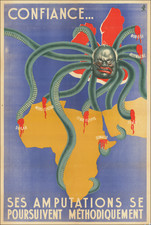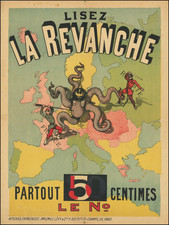The First Printed Portolan Chart of the Mediterranean, Drawn from the Work of an Important Portuguese Family of Portolan Chart Makers
One of the rarest charts of the sixteenth century, and the first printed portolan chart. It is based on the work of Diogo Homan and has been masterfully restored.
Forlani’s work marks the first transition of the portolan from manuscript to copperplate printing. Indeed, a crack in the plate is visible in the lower center of the print.
The chart shows the Mediterranean and contiguous areas, from the Canaries and Ireland to the Black Sea.
The chart is criss-crossed by rhumb lines, one of the genre’s defining features. The Mediterranean is minutely rendered, with place names radiating inland, the better to see the stippled waters for navigation.
The dedication in the far northern lands bears the name of Giacomo Murari, a Venetian nobleman to whom Forlani dedicated several of his works.
This chart is based on the work of Diogo Homem, who made a series of portolan charts in the 1550s and 1560s. The son of Lopo Homem, who also was a chartmaker, Diogo had to flee Portugal under suspicion of having committed a murder. He went first to England and then Venice, where he interacted with Forlani. It was also there where he produced his many fine manuscript charts.
This chart marks a fascinating moment in hydrographic history. While portolan-style charts continued to be made in manuscript well in the seventeenth century, the sea chart more generally, which evolved in style and content, became a primarily printed object in the late-sixteenth century. This was spurred in large part by the publication, two decades after this chart appeared, of Lucas Janszoon Waghenaer’s pioneering printed sea atlas.
Portolan charts are some of the most revered of cartographic objects, valued for their aesthetic, iconographic, and technical qualities. They are also historically significant, one of the first types of maritime charts and one of the earliest genres of regional mapping. Portolans developed in the medieval Mediterranean, but they combine elite and craft knowledge from Arab, Byzantine, Western Asian, as well as European navigational and mapping traditions. As Sonja Brentjes explains, “medieval adorned portolan charts are highly complex, polyglot cultural products that bespeak the creativity of their makers and the curiosity of their users, as well as the complexities of cultural interaction in the Mediterranean.”
The modern charts in use today find their lineage in Mediterranean portolan charts. However, earlier charts are known in Chinese and Arab contexts. Additionally, the development of the chart was not a foregone conclusion. Charts are first recorded at the conjunction of several world historical trends, including the expansion of trade over wider maritime networks, and at the conjunction of several navigational technologies, including the written sailing direction, or rutter, and the use of the magnetic compass, originally invented in China. The earliest known list of ports and coastal features, a periplus, was used by the Greeks, with an example surviving from the fourth century CE. These textual sailing directions are known to have existed alongside visual aids in the Mediterranean from at least the thirteenth century CE.
The word portolan developed from the Italian word for sailing directions, portolano or portulano, again underlining the close connection between different types of navigational tools. The first surviving portolan chart dates to ca. 1290. The Carte Pisane, probably made in Genoa and held at the Bibliotheque Nationale in Paris, depicts the Mediterranean Sea, as do many portolan charts. While the earliest example of a navigational chart to survive, it is certainly not the first of its type, as its striking accuracy and defined features attest. The development of the portolan chart before the Carte Pisane, that is, before we have reliable sources, is still a hotly contested academic debate.
Portolan charts typically consist of ink on vellum, made of calfskin, or parchment, usually goatskin. Vellum and calfskin are durable, an important attribute for objects that were to be used in the trying conditions of a ship at sea. Additionally, vellum and parchment can be corrected by scraping off a layer of ink and replacing it with new words or images, which was useful for correcting changeable navigational information. While many portolans were made to be used at sea, those that survive are usually those that were intended for an easier life on land, as luxurious presentation items, decorations, or instructional aids. Those that saw service at sea seldom survived the ordeal to enter the historical record, but other sources mention their use aboard ships.
Portolan charts share a set of conventions that would become standard for later nautical charts. They usually include a scale bar, although the unit of measure differed depending on its place of production. Important port names were written in red, while others were listed in black. These were written at right angles to the shore, and were written inland, so as not to obscure the coastline. Black dots or a cross were used to indicate rocks, while red dots indicated sandy shallows or a sandbar. Inland areas were usually devoid of geographic content, but could be filled with decoration and imagery indicating the ruler and religion prevalent in each place, not to mention local animals, plants, and other details.
Another defining feature of portolan charts are the rhumb lines, or loxodromes, that crisscross their surfaces. Rhumb lines are lines of consistent bearing. Originally, they were based on wind roses of 16 or 32 directions. The main winds would be indicated in black (or sometimes red), half winds in green, and quarter winds in red. Scholars have shown that this matrix of lines was laid down first, followed by the coasts and names, indicating that these charts were intended as instruments to find direction and bearing, not just as representations of space. Later portolan charts have the rhumb lines join at compass roses, which use cardinal and ordinal directions.
Many surviving portolans show the Mediterranean coastline, but others also depict the Black Sea, the Atlantic Coast of Europe and West Africa, the Indian Ocean, and other maritime spaces. While primarily meant to communicate nautical details, they also integrate larger geographic ideas such as the re-popularization of Ptolemy in the Renaissance. Their zenith was in the fourteenth and fifteenth centuries, but they continued to be made up to roughly 1700. The main early centers of production were Genoa, Venice, and, later, Catalonia, with important hubs in Mallorca and Sicily.
Paolo Forlani (fl. ca. 1560-1571) was a prolific map engraver based in Venice. All that is known of his life are his surviving maps and prints, of which there are almost 100 (185 with later states included in the total). He also produced a globe and two town books. It is likely he came from Verona and that he died in Venice in the mid-1570s, possibly of the plague.










![[The Travels of Paul] Tabula Geographica, in qua omnes regiones, urbes, oppida, et loca describuntur, quorum mentio fit in Actis et Epistolis Apostolotum, et Apocalypsi; de integro multis in locis emendata, ac regionum limitibus distincta, auct. Pet. Planc. . . .](https://storage.googleapis.com/raremaps/img/small/77970.jpg)



![(Data Visualization - Table of Distances) Germaniae Aliorumque Quorundam Locorum Europae Poliometria | Richtige Anzeige wei weit die Haupt-Orte in Deutschland und andere berühmte Staedte in Europa von einander entlegen, heraus gegeben von Tobias Conrad Lotter Geogr. in Augsburg. [Polymetry of Germany and Some Other Places in Europe | Accurate display of how far the main locations in Germany and other famous cities in Europe are from each other, published by Tobias Conrad Lotter, Geographer in Augsburg.]](https://storage.googleapis.com/raremaps/img/small/97280.jpg)